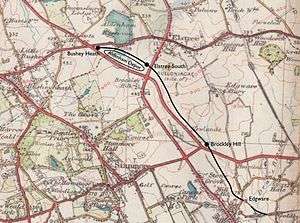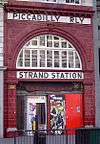Elstree South tube station
| Elstree South | |
|---|---|
 Elstree South Location of Elstree South in Hertfordshire | |
| Location | Elstree |
| Local authority | Hertsmere |
| Grid reference | TQ175946 |
| Number of platforms | 2 (planned but not built) |
| Railway companies | |
| Original company | London Underground |
| Other information | |
| Lists of stations | |
| WGS84 | 51°38′17″N 0°18′13″W / 51.63794°N 0.30349°WCoordinates: 51°38′17″N 0°18′13″W / 51.63794°N 0.30349°W |
|
| |
Elstree South (usually just Elstree on Underground maps) was a proposed London Underground station in Elstree, Hertfordshire. It was designed by Charles Holden. The planned location of the station was adjacent to the A5183, north of the junction with the A41 and where junction 4 of the M1 motorway was subsequently built.
History

The station was the second of three planned by London Underground in 1935 for an extension of the Northern line from Edgware to Bushey Heath.
The extension was part of the Northern Heights project which was intended to electrify a number of steam-operated London and North Eastern Railway (LNER) branch lines and to incorporate them into the Northern line. The powers to build the extension came from the purchase in 1922 of the unbuilt Watford and Edgware Railway which had planned an extension of the Edgware, Highgate and London Railway to Watford Junction via Bushey, but had never been able to raise the capital required for construction to start.

Construction works on the Northern Heights project began in the late 1930s but were interrupted by the outbreak of the Second World War. Most of the work undertaken to that date had been carried out on the existing LNER branch tracks but some work between Edgware and Elstree had taken place. Land had been purchased along the route of the new rail line and some earthworks had been constructed. North of Brockley Hill station a pair of 500m tunnels were partly constructed through a hill towards Elstree. The northern tunnel mouths would have opened immediately before the station. Also adjacent to the site the carriage depot for the line was completed in 1939 but during the war it was converted to use as a munitions factory. After the war it became Aldenham Bus Overhaul Works until it was closed in the 1980s and demolished in the 1990s.
The sites of all three new stations were in semi-rural locations and, as it had elsewhere, it was intended that the opening of the new section of Underground line would stimulate the construction of new residential estates that the stations would then serve. After the war, new legislation was introduced to limit the continuing expansion of urban areas into their surrounding countryside. This legislation created the Metropolitan Green Belt around London and the area designated included the area covered by the new Northern line extension. Without the possibility of constructing the new housing estates, the new line had no purpose and the plans for the extension were cancelled in 1950.
Through disuse the Elstree tunnels became flooded and dangerous. The entrances were filled in and buried in the 1970s and today nothing is visible on the surface. The extensive cutting created for the motorway junction and slip roads crosses the tunnel alignment. Some traces of earthworks and foundations of a viaduct still survive at the site of Brockley Hill station. The route of the line between Edgware and Brockley Hill is now occupied by housing and roads including Sterling Avenue and Shelley Close.
See also
- Edgware, Highgate and London Railway - LNER branch line taken over by London Underground as part of the Northern Heights project
External links
References
- Beard, Tony, 2002. By Tube beyond Edgware. Capital Transport, ISBN 1-85414-246-1
| Abandoned Northern Heights Extension | ||||
| Preceding station | Following station | |||
|---|---|---|---|---|
Terminus | Northern line | |||
